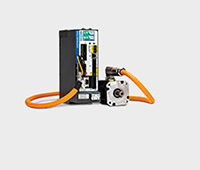By Travis Hunter
When simulation analysis results for the widely used “hot-fill” process of packaging liquids did not correlate to lab tests, Graham Packaging Company began searching for a new simulation method that would yield accurate results. It needed to experiment with different package designs to anticipate deformation during the hot-fill process, and simulation offered a fast and economical way to iterate designs without physical prototypes.
The search led to a new and more accurate material model for demonstrating the changes in the thermal characteristics of polyethylene terephthalate (PET) packaging during the hot-fill process. The new solution combines advanced simulation and analysis software with a material card that makes PET properties part of the calculations. It reduced the difference between simulation results and lab test results from the 30% range down to single digits.
The hot-fill process ensures that the contents of bottles, jars, packages, and so on, are contamination-free and resist spoilage. In a typical fill process for juices and isotonics (e.g. a sports drink with salt contents similar to the human body), the liquid needs to be heated to near boiling temperatures to make the product shelf stable. Depending on the type of product, the temperature of the liquid is approximately 185º Fahrenheit at the time of fill.
The filled container is then cooled over a period of time to room temperature. During the change in temperature the product contracts due to the change in the product’s density. This change is why there is a need to understand how the bottle reacts as the product inside cools.
PET is a thermally sensitive material. There is a significant difference in its stress strain curve at 185ºF than at 72ºF, shown in Figure 1, which also demonstrates how much weaker the material is at 185ºF.
 The change in the liquid’s temperature has dramatic effects on the PET container. As the liquid inside the bottle cools, the negative change creates a vacuum and the bottle deforms. The deformation needs to be controlled by modifying the bottle’s design or the bottle will not pass requirements for labeling and customer handling.
The change in the liquid’s temperature has dramatic effects on the PET container. As the liquid inside the bottle cools, the negative change creates a vacuum and the bottle deforms. The deformation needs to be controlled by modifying the bottle’s design or the bottle will not pass requirements for labeling and customer handling.
Controlling the deformation requires many design iterations as well as time to evaluate prototypes. Engineers using simulation technology can make educated decisions on which design will have the best performance with minimal time and cost without waiting for testing results from prototypes.
Initially, Graham Packaging simulated the hot-fill process by applying a negative pressure to the surfaces of the bottle. These results helped engineers design a package that would deform predictably and within acceptable limits. However, there had to be a high safety factor applied to the analysis because the results deviated by as much as 30% from actual lab samples.
To improve accuracy, Graham evaluated a new fluid-filled material properties card, which reduced the safety factor into the 20% range. The speed of the analysis improved, but there was still some discrepancy in the simulated results versus lab results. Therefore, additional improvements needed to be made to the material card in the analysis to best represent the real-world results.
Part of the problem was that Graham’s original material model had only one stress-strain curve at one temperature. That was a significant limitation because the hot-filled simulation experienced large temperature changes, and the material property – the stress-strain curve – depends highly on temperature.
Graham’s breakthrough occurred when it combined MSC Software’s Nastran multidisciplinary structural analysis application and its MATD106 material property card. MATD106 enabled Graham to use multiple stress-strain curves instead of just one. The multiple curves more accurately simulated actual fill conditions, such as the volume of the liquid and the temperatures.
Using the MATD106 card greatly improved the accuracy of the analysis, and the simulation results were finally very similar to lab data. With the latest advances in the material card and improvements made to the material properties, the hot-fill simulation finally follows lab data within a couple of percentage points. This improved accuracy in the analysis has led to greater innovation in bottle design, faster speed to market, and material savings.
MSC Software
www.mscsoftware.com
Filed Under: ENGINEERING SOFTWARE, Packaging, MOTION CONTROL, MORE INDUSTRIES





Tell Us What You Think!